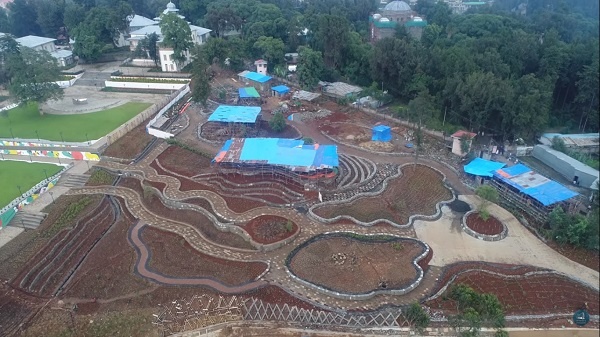
“Unity Park symbolizes our ability to come together for a common goal and cross the finish line by, creating an exquisite lasting prints of our collective worth.” Office of the Prime Minister – Ethiopia
By Robbie Corey-Boulet (AFP)
ADDIS ABABA – A palace that once housed Ethiopia’s emperors and also served as a torture site under the communist Derg regime is to open to the public in a controversial government tourism project.
The palace compound in Addis Ababa, which Prime Minister Abiy Ahmed’s government has rebranded “Unity Park”, was formally launched on 10 October 2019 and will be open 11 October 2019.
Abiy’s office said on Twitter Thursday (October 10) that the project “symbolizes our ability to come together”.
But critics have dismissed it as vanity project for Abiy that could prove divisive.
Backed by the United Arab Emirates, the Unity Park project cost more than $160 million (€145 million), Ethiopian officials told reporters at a briefing earlier this week.
Built in the late 1800s by Emperor Menelik II, who founded Addis Ababa, the palace was the residence of Ethiopia’s rulers for more than a century.
Prime Minister Abiy Ahmed himself does not live there, and it has seen little activity in recent years.
Abiy’s advisers say he has taken a keen interest in transforming the palace into a tourist attraction since coming to power in April 2018 — visiting the site every day in recent weeks to monitor progress.
The government’s “Home-Grown Economic Reform” agenda, unveiled last month, describes tourism as a primary engine of potential job creation.
On 10 October 2019, government officials and the diplomatic corps toured the expansive site before attending a banquet that was expected to draw five regional heads of state and other dignitaries.
The restored rooms feature items like Menelik’s sword and a life-size wax replica of former Emperor Haile Selassie, who lived at the palace and was then detained there after the Derg overthrew him in 1974.
The site also includes a sculpture garden with installations representing Ethiopia’s nine regions, and a zoo is expected to open by the end of the year.
Aklilu Fikresilassie, an Ethiopian employee of the United Nations who attended the launch 10 October 2019, said he was “really fascinated” to set foot inside a place that had been closed to the public his entire life.
“For us it’s like a government house, so now when you enter that palace it tells you that we are getting somehow closer to our leaders,” he said.
But not everyone is convinced the palace will succeed in bringing Ethiopians together.
In a country grappling with ethnic divisions, some worry that the palace could alienate ethnic Oromos who contend that their ancestors were forced off their land when Addis Ababa was built.
Journalist and former political prisoner Eskinder Nega said the renovations were undertaken “without consultation from the public”, which he called “a huge mistake.”
“This is all about heritage, about preserving heritage. The people should have had a say in it,” he said.
“Like everything else this was decided from the top and implemented only by the decision of the prime minister.”
